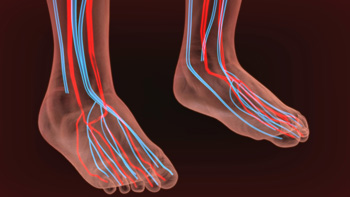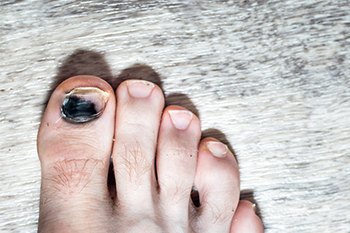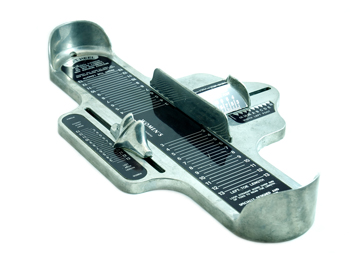Items filtered by date: June 2023
The Feet Can Be Affected by Poor Circulation

Symptoms that are associated with poor circulation can include cold or discolored feet, and there may be numbness or a tingling sensation. Poor circulation can come from closed, hardened, or narrowed blood vessels that can prevent adequate blood, oxygen, and nutrients from being transported through the body. There may be underlying reasons that can lead to poor circulation. These can include Raynaud’s disease, which can limit blood flow to the fingers and toes, and acrocyanosis, causing the toes to turn blue from constricting blood vessels. Additionally, poor circulation is common among diabetic patients as a result of damaged blood vessels. Poor circulation may also affect people who smoke, are inactive, or who have high cholesterol or blood pressure. Mild relief may be found when the feet are massaged, relaxation techniques are practiced, and physical activity is increased. If you have symptoms of poor circulation, it is suggested that you confer with a podiatrist who can offer you the correct treatment options.
While poor circulation itself isn’t a condition; it is a symptom of another underlying health condition you may have. If you have any concerns with poor circulation in your feet contact Thomas Vail, DPM of Step Alive Foot & Ankle Center. Our doctor will treat your foot and ankle needs.
Poor Circulation in the Feet
Peripheral artery disease (PAD) can potentially lead to poor circulation in the lower extremities. PAD is a condition that causes the blood vessels and arteries to narrow. In a linked condition called atherosclerosis, the arteries stiffen up due to a buildup of plaque in the arteries and blood vessels. These two conditions can cause a decrease in the amount of blood that flows to your extremities, therefore resulting in pain.
Symptoms
Some of the most common symptoms of poor circulation are:
- Numbness
- Tingling
- Throbbing or stinging pain in limbs
- Pain
- Muscle Cramps
Treatment for poor circulation often depends on the underlying condition that causes it. Methods for treatment may include insulin for diabetes, special exercise programs, surgery for varicose veins, or compression socks for swollen legs.
As always, see a podiatrist as he or she will assist in finding a regimen that suits you. A podiatrist can also prescribe you any needed medication.
If you have any questions, please feel free to contact our office located in Findlay, OH . We offer the newest diagnostic and treatment technologies for all your foot care needs.
Toenail Issues Common to Runners

Distance runners often experience problems with their toenails, and the three main types are thick nails, bruised nails, and toenail loss. While in many cases the appearance of thick toenails can indicate a fungal infection, in runners they can also be a result of pressure from their shoes and socks, or wearing shoes that don’t fit properly. A toenail that looks blue or black is likely to be caused by a bruise underneath it. The change in color is caused by blood forming under the nail, often from direct trauma to the toe. In some cases, the blood will need to be drained in a medical procedure conducted by a podiatrist. Many runners are surprised when one of their toenails falls off. In most cases, a new nail will form. To avoid losing a toenail, experts recommend being sure that your running shoes fit well, keeping toenails properly trimmed, and making sure your shoes are completely dry before a run. If you notice a bruise, a thick nail, or a loose toenail, it is suggested that you consult a podiatrist sooner rather than later, before the matter worsens and prohibits you from running.
Exercising your feet regularly with the proper foot wear is a great way to prevent injuries. If you have any concerns about your feet, contact Thomas Vail, DPM of Step Alive Foot & Ankle Center. Our doctor will treat your foot and ankle needs.
How to Prevent Running Injuries
Many common running injuries are caused by overuse and overtraining. When the back of the kneecap starts wearing out and starts causing pain in your knee, this is commonly referred to as runner’s knee. Runner’s knee is a decrease in strength in your quadriceps and can occur if you’re not wearing properly fitted or supporting shoes. To prevent runner’s knee, focusing on hip strengthening is a good idea, as well as strengthening your quads to keep the kneecaps aligned.
What Are Some Causes of Running Injuries?
- One cause of a common running injury is called iliotibial band syndrome.
- Plantar fasciitis is also another common injury.
- Stress fractures can occur from overtraining, lack of calcium, or even your running style.
Best Ways to Prevent Running Injuries
- Wear footwear that fits properly and suits your running needs.
- Running shoes are the only protective gear that runners have to safeguard them from injury.
- Make a training schedule. Adding strengthening exercises as well as regular stretching can help keep you strong and limber and can lessen the possibility of injuries.
- Stretching keeps muscles limber; this will help you gain better flexibility.
If you have any questions please feel free to contact our office located in Findlay, OH . We offer the newest diagnostic and treatment technologies for all your foot and ankle needs.
What Is the Brannock Device?

One of the most effective methods of measuring the feet is by using a Brannock device. It was invented in 1925 by Charles Brannock, and has improved traditional foot-measuring techniques. This device is described as a base plate that has graduated markings. The foot is placed on this plate and the length and width of the foot can be accurately measured. This device can also measure the distance from the heel to the ball of the foot. The Brannock device was widely used among various military branches to ensure that enlisted men and women wore the correct shoe size. This measuring tool is generally found in the majority of shoe stores. People who purchase their shoes online may not have access to this device, and will often use other methods of obtaining an accurate foot measurement. If you would like to learn more about the Brannock device and other techniques of measuring the feet, it is suggested that you speak to a podiatrist who can provide you with the information you are seeking.
Getting the right shoe size is an important part of proper foot health. Seek the assistance of Thomas Vail, DPM from Step Alive Foot & Ankle Center. Our doctor will provide the care you need to keep you pain-free and on your feet.
Getting the Right Shoe Size
There are many people who wear shoes that are the incorrect size, negatively affecting their feet and posture. Selecting the right shoes is not a difficult process, so long as you keep several things in mind when it comes to choosing the right pair.
- When visiting the shoe store, use the tools available to measure your foot.
- Be sure there is ‘wiggle room’. There should be about an inch between your toes and the tip of your shoes.
- Do not always assume you are the same size, as manufacturers run differently.
- Purchase shoes later in the day, as your feet swell as the day progresses.
- If a shoe is not comfortable, it is not suitable. Most shoes can’t be ‘broken in’, and comfort should be the ultimate goal when it comes to choosing the right pair of shoes
As our feet hold our body weight and keep us moving, it is important to treat them right. Picking the right pair of shoes can provide your feet comfort and mobility without pain.
If you have any questions, please feel free to contact our office located in Findlay, OH . We offer the newest diagnostic and treatment technologies for all your foot care needs.
